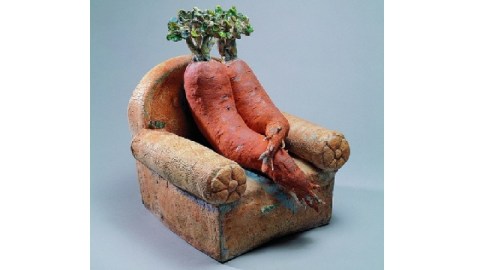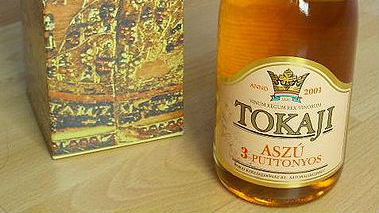What’s So Funny About Modern Art?

Modern art takes itself much too seriously. Even the Pop artists often took the fun out of whatever they touched—a reverse Midas touch rendering even comedy gold into dross. Andy Warhol immortalized Elvis and Marilyn not at their peak of pure joy, but at their most tragic low. In Renegade Humor, which runs at the San Jose Museum of Art through July 8, 2012, the search for a sense of humor in modern art finally succeeds. Gathering together art since 1960 from the SJMA’s collection as well as pieces designed especially for the exhibition, Renegade Humor goes maverick and bucks the trend. Renegade Humor plays for laughs, but also proves that you can laugh and think at the same time.
The brand of humor Renegade Humor hopes to sell has its origins in “the bawdy irreverence, parody, and puns that are hallmarks of the work spawned at the University of California, Davis, in the 1960s and 1970s,” according to the press release. According to curator Jodi Throckmorton, “The artists of the Davis School jettisoned what they viewed as the pretension of the East Coast art world and adopted an earthy approach wholly authentic to the West Coast. The use of funny or unexpected imagery to tackle difficult, sometimes shocking topics has been a recurring theme in California art to this day.” Just as the New York-based art world overshadowed happenings on the Left Coast for decades (and still keeps many art history texts in the dark), perhaps modern art’s been funny all along, but just not in the cold, dark Northeast section of the U.S. Just as the state-wide Pacific Standard Time coordinated art initiative aims at rewriting (or writing correctly at last) the story of the true center of American art in the 20th century, Renegade Humor aims at your funny bone to show just one (and decidedly un-New York) side of that recovered history.
Puns may be the last refuge of a comedy scoundrel, but visual puns can still pack a punch when done properly. Peter VandenBerge’s 1969 sculpture Couple Watching Saturday Night Movie (shown above) takes the idea of “vegging out” in front of the tube literally by replacing a reclining couple with two carrots snuggling in a chair. It’s a simple idea rendered with excellent technique. It’s also a commentary on the too comfortable, too unthinkingly vegetative state of many Americans in 1969, when the Vietnam War took American and Vietnamese lives on the other side of the globe and the debate over the conflict split the nation right outside your front door. When Walter Cronkite tried to bring the war into your living room through the nightly news, did you watch and think or did you put on Fantastic Voyage and comfortably veg away? I’m guessing that VandenBerge made the carrot his vegetable of choice over the conventional couch potato because potatoes sometimes have eyes.
In addition to existing works by VandenBerge, art by other Davis alums such as Robert Arneson, Roy de Forest, David Gilhooly, and William T. Wiley fill the show. Non-Davis-affiliated, but still Californian artists such as John Bankston, Ray Beldner, Squeak Carnwath, Enrique Chagoya, Robert Colescott, Robbie Conal, Brian Goggin, Llyn Foulkes, Viola Frey, Jane Hammond, Evri Kwong, Lynn Hersman Leeson, Marilyn Levine, Bruce Nauman, Dennis Oppenheim, Nathan Redwood, Walter Robinson, Richard Shaw, and M. Louise Stanley also appear. If you have the time, click on the links attached to the names to get a visual tour of the California art scene of the last half century. What a long, strange trip it’s been…
Adding to that list (and extending the trip) are new works by Kathy Aoki and Imen Yeh commissioned just for the show. Aoki built 3-foot-tall “paper” (actually steel) dolls of President Barack Obama, once and future presidential hopefuls Sarah Palin and Newt Gingrich, and former California Governor Arnold Schwarzenegger. Paper clothes and other accessories will allow visitors to play dress up and, for example, deck out Palin in “mama grizzly” suit, or see how it looks on the former Mr. Universe. Not satisfied with real candidates, Yeh has created a fictional Latino-Asian politician named “Juan Ton.” Mr. Ton’s cross-over marketability takes the form of t-shirts, posters, and buttons, plus the fixings for visitors to make their own Juan Ton campaign buttons. If you can’t make it to San Jose, you can visit Juan Ton’s Facebook page and post photos of you showing your support. Just as Michael Nesmith turned patriotic Cuban song “Guantanamera” into “One Ton Tomato,” Yeh turns American politics and the primary and election seasons into farce (as if the politicians themselves hadn’t already done that).
I was surprised that Peter Saul’s name wasn’t included in this mix, but that exclusion got me thinking. Assuming that Saul wasn’t excluded for practical reasons such as a work wasn’t available, I think that Saul’s more acidic, scatological kind of humor didn’t belong in this cooler kind of California comedy. Renegade Humor is more Jerry Seinfeld than Lenny Bruce, not that there’s anything wrong with that. Like Peter VandenBerge’s carrot couple on the sofa, viewers of Renegade Humor should be comfortable in the galleries and lured in by the laughs and thinking about social issues before they even realize it.
[Image:Peter VandenBerge. Couple Watching Saturday Night Movie, 1969. Ceramic. 13 x 12 x 11 inches. San Jose Museum of Art. Museum purchase with funds from the Collection Committee.]
[Many thanks to the San Jose Museum of Art for the image above and other press materials related to Renegade Humor, which runs through July 8, 2012.]





